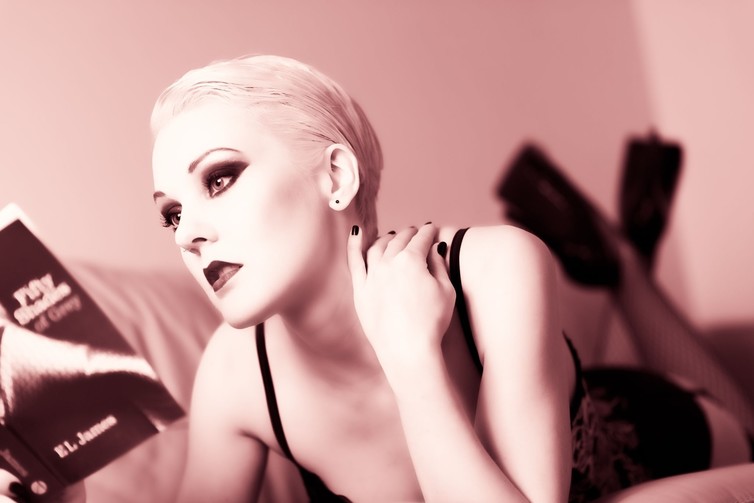E L James’s Fifty Shades trilogy is a bona fide publishing, and now film, sensation. Along with e-reading devices, it has been the single most important contributor to the mainstreaming of erotic literature. ![]()
The sheer number of parodies, both straight and gay, lend further evidence to the influence of the novels in pop culture. Whatever you think about the trilogy and its film adaptations, it cannot be doubted that Fifty Shades has brought alternative sexualities in general and BDSM, in particular, to the masses, writes Duc Dau.
A brief history of erotica
Erotica has a long and varied history, which extends at least as far back as the ancient Indian handbook of love and sex, the Kama Sutra.

In a more recent western context, much of the history of erotica is inseparable from that of pornography and obscenity. Historically important works that were once considered obscene or were prosecuted under obscenity laws include the works of the Marquis de Sade (1740-1814), John Cleland’s Fanny Hill (1749), James Joyce’s Ulysses (1922), D. H. Lawrence’s Lady Chatterley’s Lover (1928), and Henry Miller’s Tropic of Cancer (1934).
These novels are known for their opposition to clerical or conventional authority, to sexual hypocrisy or to all three. In varying degrees and ways, their authors were invested in depicting eroticism, whether the undeniably shocking (de Sade, from whose name we derive the word “sadism”) or sometimes peculiar (Lawrence).
Today’s mainstream erotica, often self-published for the digital market, is largely devoid of political and social critique. It draws heavily on the genre of the romance novel, which ranges from Jane Austen’s works to the mass-market novels produced by publishing companies like Harlequin and its subsidiary Mills and Boon. Fifty Shades falls into this category of mainstream erotica, though with a smattering of BDSM and pop feminism.
In turn, publisher Harlequin has adapted to the rise in e-books and to readers’ interest in more hardcore material. Following the unprecedented success of Fifty Shades, Harlequin released several BDSM titles such as Bonds of Trust on its digital imprint, Carina Press.
The uses of humour
What hasn’t been discussed extensively about the Fifty Shades trilogy is its use of humour. Indeed, humour in contemporary erotica is a topic that has remained largely untouched.
One of the key aims of erotica is to titillate, and whichever way you look at it, sex is often funny: the way we do it, depict it, and seek it. We can even laugh during sex, such as when the body does something embarrassing.

Universal Pictures
Fifty Shades is frequently comical, whether intentionally or not. I’ll stick to the intentional humour. In the first book, Fifty Shades of Grey, emails exchanged between fated couple Anastasia and Christian are often playful, teasing, and witty.
Emailing allows the characters to communicate their desires, needs, and personalities more openly than in person. It also offers Anastasia the space to demonstrate sexual agency. Just as importantly, the emails reveal in abundance the frisson that can be had in playful intellectual exchange.
This letter-writing element adds an underappreciated sexual dimension to the novel. The humorous moments offer a counterweight to the conflict surrounding Anastasia’s need for tenderness and mutuality and Christian’s need for dominance and sadism.
Victorian literature gets an erotic makeover
Anastasia playfully compares herself to the innocent Tess and Christian to the rakish Alec, characters from Thomas Hardy’s Tess of the d’Urbervilles (1891), a Victorian novel that Fifty Shades of Grey frequently references. The Victorians have become fashionable in erotic literature.
Indeed, nineteenth-century classics of the young woman’s encounter with an older and wealthier man have also been given erotic makeovers. Inspired by the success of Fifty Shades, they include explicit sexual content, and have titles such as Pride and Penetration and Jane Eyrotica.

Goodreads
In Eve Sinclair’s Jane Eyre Laid Bare, Jane is a sexually curious bisexual who, as in Charlotte Brontë’s Jane Eyre (1847), falls for the dark and mysterious Rochester (another character who is clearly a precursor to Christian Grey).
Humour in the novel adds lightness to the topic of both the Victorians (traditionally viewed as earnest) and sex: the sex-on-horseback-in-the-rain scene, partly because it draws on the phrase “dear reader,” is sure to elicit chuckles and thrills from many readers familiar with the original novel.
Whereas Brontë had famously written, “Reader, I married him. A quiet wedding we had: he and I, the parson and clerk, were alone present,” Sinclair writes, “And with that, dear reader, he cupped his strong hands beneath my buttocks and raised me, as though I weighed no more than a bird, and simultaneously employed his fingertips to sweep my undergarments aside,” etc.
Queer erotica
Jane Eyre Laid Bare includes scenes of queer sex, though the novel is mostly aimed at a straight female readership. For queer people (gay, lesbian, bisexual, transgender, and other people of diverse sexualities and genders), visibility matters, and sexual expression is one significant dimension of this visibility.
Queer humour is a mechanism for survival and defiance. Coupled with erotica, it aligns with Brian McNair’s definition of sexuality:
Sexuality is and always has been in large part about the exploration of fantasy, and in fantasy rules are broken, sins committed, boundaries crossed, including those put in place not just by the predatory barons of patriarchy, but by … radical feminism.
With that, I’d like to conclude with the work of the self-published author Chuck Tingle. Tingle is the originator of Brexit and Pokemon gay erotica. Unsurprisingly, he has turned his hand and sense of humour to another contemporary and political event: the rise of President Donald Trump.
A mishmash of several genres including dinosaur erotica, its storyline is simple and spoofs its main character.
It is patently absurd, but this is erotica that ridicules a leader who favours censorship and under whom many queer people live with a sense of uncertainty. Satirical erotica, like laughter, is but one way to survive this reality, as the Amazon reviews imply.
In its own unique way, Tingle’s story is a throwback to the censored erotic works of the past. It explores terrain that Fifty Shades, for all its notoriety, would not have dared to venture.
Duc Dau, Honorary Research Fellow, University of Western Australia
This article was originally published on The Conversation. Read the original article.























Add Comment